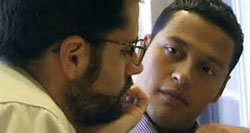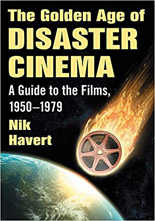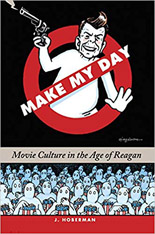 In a summer that has seen several sequels tank, at least one doesn’t disappoint: Make My Day: Movie Culture in the Age of Reagan, preeminent film critic J. Hoberman’s trilogy-capper. As An Army of Phantoms and The Dream Life considered American cinema in the Cold War and the 1960s, respectively, Make My Day looks to the late 1970s and the whole of the 1980s; as in those works, also from The New Press, American cinema is also considered through the lens of the era’s politics, and how one informed or reflected the other. With Ronald Reagan as movie star-cum-POTUS, Hoberman certainly has a wealth of material to parse, most notably in the “warnography” of Rambo: First Blood Part II, Top Gun, Iron Eagle and, to a lesser degree, WarGames. It’s not all jets and jocks, either, with everything from the narrative quilt of Nashville to the science-fried comedy of Ghostbusters and basically everything Steven Spielberg Midas-touched. The tour is fascinating, politically charged (yet fact-based) and even thrilling. An overuse of the prefix “crypto-” and a couple of names getting botched (as Jon Voigt, Gary Marshall and Christian Glover) do nothing to diminish its excellence.
In a summer that has seen several sequels tank, at least one doesn’t disappoint: Make My Day: Movie Culture in the Age of Reagan, preeminent film critic J. Hoberman’s trilogy-capper. As An Army of Phantoms and The Dream Life considered American cinema in the Cold War and the 1960s, respectively, Make My Day looks to the late 1970s and the whole of the 1980s; as in those works, also from The New Press, American cinema is also considered through the lens of the era’s politics, and how one informed or reflected the other. With Ronald Reagan as movie star-cum-POTUS, Hoberman certainly has a wealth of material to parse, most notably in the “warnography” of Rambo: First Blood Part II, Top Gun, Iron Eagle and, to a lesser degree, WarGames. It’s not all jets and jocks, either, with everything from the narrative quilt of Nashville to the science-fried comedy of Ghostbusters and basically everything Steven Spielberg Midas-touched. The tour is fascinating, politically charged (yet fact-based) and even thrilling. An overuse of the prefix “crypto-” and a couple of names getting botched (as Jon Voigt, Gary Marshall and Christian Glover) do nothing to diminish its excellence.
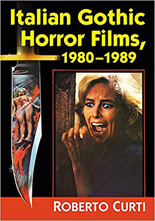 Serious question: Does Roberto Curti ever sleep? The Italian film historian has been averaging two research-heavy books a year, with his latest being Italian Gothic Horror Films, 1980-1989. Those already familiar with Curti will know this is the third in the IGHF series, which began in 2015 (1957-1969) and continued in 2017 (1970-1979), all published by McFarland & Company. The VHS-weaned generation may have been waiting on this one all along, given that the video-store era coincided with the gore-heavy auteurist period of Dario Argento, Lucio Fulci, Lamberto Bava and others, who made some of their best work in this fertile period. Again going chronologically, Curti examines each notable title, with critical and historical appreciations that can run for multiple pages, if merited (the above men among those). If there’s a fly in this soup, it’s that Curti refers to films primarily by their Italian titles, which can get tricky if you’re not paying attention, assuming you’re also not bilingual. Molto bene!
Serious question: Does Roberto Curti ever sleep? The Italian film historian has been averaging two research-heavy books a year, with his latest being Italian Gothic Horror Films, 1980-1989. Those already familiar with Curti will know this is the third in the IGHF series, which began in 2015 (1957-1969) and continued in 2017 (1970-1979), all published by McFarland & Company. The VHS-weaned generation may have been waiting on this one all along, given that the video-store era coincided with the gore-heavy auteurist period of Dario Argento, Lucio Fulci, Lamberto Bava and others, who made some of their best work in this fertile period. Again going chronologically, Curti examines each notable title, with critical and historical appreciations that can run for multiple pages, if merited (the above men among those). If there’s a fly in this soup, it’s that Curti refers to films primarily by their Italian titles, which can get tricky if you’re not paying attention, assuming you’re also not bilingual. Molto bene!
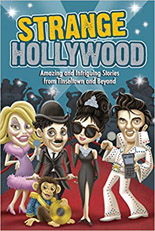 Portable Press’ Strange Hollywood is not unlike an entry in the assumedly immortal Uncle John’s Bathroom Reader series: a chunky little book to absorb a page or two at a time, most likely during dumps, with contents only slightly less temporary. Thus, lists make up much of the 400-plus pages, from movie stars’ final roles and original titles of hit pictures to fun facts about The Muppets and memorable quips from TV’s Hollywood Squares. Occasionally, there’s even an anecdote worth your time, such as why Tommy Lee Jones couldn’t stand working with Jim Carrey on Batman Forever, resulting in the former telling the latter, “I cannot sanction your buffoonery.” All in all, the book is a novelty that might work as a stocking stuffer. —Rod Lott
Portable Press’ Strange Hollywood is not unlike an entry in the assumedly immortal Uncle John’s Bathroom Reader series: a chunky little book to absorb a page or two at a time, most likely during dumps, with contents only slightly less temporary. Thus, lists make up much of the 400-plus pages, from movie stars’ final roles and original titles of hit pictures to fun facts about The Muppets and memorable quips from TV’s Hollywood Squares. Occasionally, there’s even an anecdote worth your time, such as why Tommy Lee Jones couldn’t stand working with Jim Carrey on Batman Forever, resulting in the former telling the latter, “I cannot sanction your buffoonery.” All in all, the book is a novelty that might work as a stocking stuffer. —Rod Lott

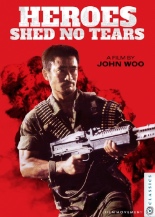
 In this life, there are many things that heroes shed but, apparently, tears are not one of them. At least that is the thesis statement behind John Woo’s 1986 testes-dropper,
In this life, there are many things that heroes shed but, apparently, tears are not one of them. At least that is the thesis statement behind John Woo’s 1986 testes-dropper, 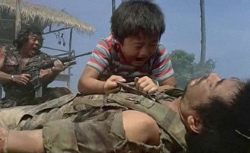


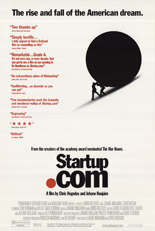
 On one internet company’s rapid rise and speedier fall, the documentary
On one internet company’s rapid rise and speedier fall, the documentary 